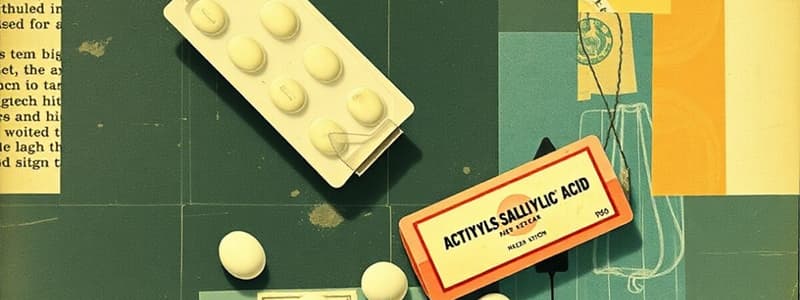Podcast
Questions and Answers
What is the mechanism of action of Acetylsalicylic Acid (ASA)?
What is the mechanism of action of Acetylsalicylic Acid (ASA)?
- Inhibits thrombin activity
- Inhibits phosphodiesterase
- Blocks platelet glycoprotein IIb/IIIa receptors
- Irreversibly inhibits COX-1 (correct)
Which of the following is a contraindication for using Acetylsalicylic Acid (ASA)?
Which of the following is a contraindication for using Acetylsalicylic Acid (ASA)?
- Active peptic ulcer (correct)
- Moderate hypertension
- Previous myocardial infarction
- Elevated cholesterol levels
Which of the following age-related considerations is important when prescribing Acetylsalicylic Acid (ASA)?
Which of the following age-related considerations is important when prescribing Acetylsalicylic Acid (ASA)?
- Decreased renal function at any age
- Increased absorption rate in elderly patients
- Lower dosing recommendation for those over 75 years
- Increased risk of Reye syndrome in children (correct)
What is a key consideration regarding the use of Acetylsalicylic Acid (ASA) in patients with hypertension?
What is a key consideration regarding the use of Acetylsalicylic Acid (ASA) in patients with hypertension?
What is ASA's role in primary prevention of cardiovascular events?
What is ASA's role in primary prevention of cardiovascular events?
What combination of medications has the highest risk of gastrointestinal bleeding according to the findings?
What combination of medications has the highest risk of gastrointestinal bleeding according to the findings?
What is the adjusted rate ratio (RR) for gastrointestinal bleeding when acetylsalicylic acid is combined with clopidogrel?
What is the adjusted rate ratio (RR) for gastrointestinal bleeding when acetylsalicylic acid is combined with clopidogrel?
Which of the following drug combinations is explicitly associated with a high risk of gastrointestinal bleeding?
Which of the following drug combinations is explicitly associated with a high risk of gastrointestinal bleeding?
What is the adjusted rate ratio indicating the risk of gastrointestinal bleeding associated with low-dose Acetylsalicylic acid?
What is the adjusted rate ratio indicating the risk of gastrointestinal bleeding associated with low-dose Acetylsalicylic acid?
What factor significantly increases the risk of bleeding in patients following acute myocardial infarction?
What factor significantly increases the risk of bleeding in patients following acute myocardial infarction?
Based on the research, which group has the highest incidence of hemorrhage-related adverse events?
Based on the research, which group has the highest incidence of hemorrhage-related adverse events?
Which risk evaluation is crucial for patients with Atrial Fibrillation concerning bleeding?
Which risk evaluation is crucial for patients with Atrial Fibrillation concerning bleeding?
What is the consequence of combining nonsteroidal anti-inflammatory drugs (NSAIDs) with clopidogrel?
What is the consequence of combining nonsteroidal anti-inflammatory drugs (NSAIDs) with clopidogrel?
What is the mechanism of action of dipyridamole in combination with aspirin?
What is the mechanism of action of dipyridamole in combination with aspirin?
What is a significant side effect associated with dipyridamole plus aspirin therapy?
What is a significant side effect associated with dipyridamole plus aspirin therapy?
Which of the following is a contraindication for the use of dipyridamole?
Which of the following is a contraindication for the use of dipyridamole?
In the context of stroke prevention, what is the NNT for patients with diabetes treated with low-dose aspirin?
In the context of stroke prevention, what is the NNT for patients with diabetes treated with low-dose aspirin?
What is the significance of a higher NNH in elderly patients using aspirin for primary prevention?
What is the significance of a higher NNH in elderly patients using aspirin for primary prevention?
Clopidogrel (Plavix) is primarily contraindicated in patients with which condition?
Clopidogrel (Plavix) is primarily contraindicated in patients with which condition?
How does dipyridamole plus aspirin compare to clopidogrel regarding the risk of major bleeding?
How does dipyridamole plus aspirin compare to clopidogrel regarding the risk of major bleeding?
For primary prevention, low-dose aspirin is not recommended unless which condition is present?
For primary prevention, low-dose aspirin is not recommended unless which condition is present?
What does the abbreviation NNT stand for in the context of medication effectiveness?
What does the abbreviation NNT stand for in the context of medication effectiveness?
What is a common side effect of aspirin therapy indicated by a 15% occurrence rate?
What is a common side effect of aspirin therapy indicated by a 15% occurrence rate?
What is the recommended daily dose of aspirin for patients on therapy?
What is the recommended daily dose of aspirin for patients on therapy?
Which of the following is associated with a higher bleeding risk when using aspirin?
Which of the following is associated with a higher bleeding risk when using aspirin?
What condition is a contraindication for high-risk patients regarding aspirin therapy?
What condition is a contraindication for high-risk patients regarding aspirin therapy?
What is the primary consideration for restarting aspirin therapy after a GI bleed?
What is the primary consideration for restarting aspirin therapy after a GI bleed?
What is the adverse effect rate of muscle weakness associated with aspirin usage based on the provided data?
What is the adverse effect rate of muscle weakness associated with aspirin usage based on the provided data?
In the context of atrial fibrillation management, what would be the primary preventative measure against stroke?
In the context of atrial fibrillation management, what would be the primary preventative measure against stroke?
When evaluating bleeding risks with aspirin use, which of the following is least likely to occur?
When evaluating bleeding risks with aspirin use, which of the following is least likely to occur?
Which combination is specifically highlighted for adverse effects in patients after high-risk procedures?
Which combination is specifically highlighted for adverse effects in patients after high-risk procedures?
What is the implication of a high NNH of 250 for aspirin usage in cardiovascular contexts?
What is the implication of a high NNH of 250 for aspirin usage in cardiovascular contexts?
Which factor would likely necessitate the addition of a PPI when prescribing aspirin?
Which factor would likely necessitate the addition of a PPI when prescribing aspirin?
What is the main finding regarding self-management of oral anticoagulation in patients?
What is the main finding regarding self-management of oral anticoagulation in patients?
What percentage of patients dropped out during the training period for self-monitoring anticoagulation?
What percentage of patients dropped out during the training period for self-monitoring anticoagulation?
What is a known limitation of the testing equipment for home monitoring of anticoagulation?
What is a known limitation of the testing equipment for home monitoring of anticoagulation?
What is one potential disadvantage of self-monitoring of anticoagulation?
What is one potential disadvantage of self-monitoring of anticoagulation?
Which study specifically focused on home-based warfarin management?
Which study specifically focused on home-based warfarin management?
Which factor is NOT mentioned as a contribution to the evaluation of bleeding risk in anticoagulation therapy?
Which factor is NOT mentioned as a contribution to the evaluation of bleeding risk in anticoagulation therapy?
Which of the following has not been established through research regarding self-management of anticoagulant therapy?
Which of the following has not been established through research regarding self-management of anticoagulant therapy?
In the context of atrial fibrillation management, what role does patient self-testing play?
In the context of atrial fibrillation management, what role does patient self-testing play?
Which anticoagulant is typically combined with warfarin for enhanced effect?
Which anticoagulant is typically combined with warfarin for enhanced effect?
Why is it important to assess stroke risk in patients receiving anticoagulation therapy?
Why is it important to assess stroke risk in patients receiving anticoagulation therapy?
What is the duration of platelet inhibition after taking Acetylsalicylic Acid (ASA)?
What is the duration of platelet inhibition after taking Acetylsalicylic Acid (ASA)?
What is a significant risk associated with the use of Acetylsalicylic Acid (ASA) in children or young adults with certain illnesses?
What is a significant risk associated with the use of Acetylsalicylic Acid (ASA) in children or young adults with certain illnesses?
In which condition is Acetylsalicylic Acid (ASA) not recommended for primary prevention?
In which condition is Acetylsalicylic Acid (ASA) not recommended for primary prevention?
What effect can uncontrolled hypertension have on patients taking Acetylsalicylic Acid (ASA)?
What effect can uncontrolled hypertension have on patients taking Acetylsalicylic Acid (ASA)?
What specific precaution is recommended for elderly patients when prescribing Acetylsalicylic Acid (ASA)?
What specific precaution is recommended for elderly patients when prescribing Acetylsalicylic Acid (ASA)?
What is a significant challenge faced by patients in self-monitoring their anticoagulation status?
What is a significant challenge faced by patients in self-monitoring their anticoagulation status?
What is one limitation of the equipment used for home monitoring of anticoagulation?
What is one limitation of the equipment used for home monitoring of anticoagulation?
What does the majority of research indicate about self-management of oral anticoagulation therapies?
What does the majority of research indicate about self-management of oral anticoagulation therapies?
What is a significant consequence of patient self-testing in anticoagulation management?
What is a significant consequence of patient self-testing in anticoagulation management?
What aspect highlights the potential advantages of home-based warfarin management services?
What aspect highlights the potential advantages of home-based warfarin management services?
Which of the following is a potential benefit of patient self-management of anticoagulation according to studies?
Which of the following is a potential benefit of patient self-management of anticoagulation according to studies?
What population did Garcia-Alamino et al. focus on regarding the self-management of anticoagulation?
What population did Garcia-Alamino et al. focus on regarding the self-management of anticoagulation?
What is one challenge associated with the high cost of home monitoring equipment for anticoagulation?
What is one challenge associated with the high cost of home monitoring equipment for anticoagulation?
What is a critical element for patients undergoing anticoagulation self-monitoring?
What is a critical element for patients undergoing anticoagulation self-monitoring?
What is the adjusted rate ratio for gastrointestinal bleeding when acetylsalicylic acid is combined with warfarin?
What is the adjusted rate ratio for gastrointestinal bleeding when acetylsalicylic acid is combined with warfarin?
Which drug combination has the lowest adjusted rate ratio for gastrointestinal bleeding according to the findings?
Which drug combination has the lowest adjusted rate ratio for gastrointestinal bleeding according to the findings?
Which medication combination is specifically noted to carry a high risk of gastrointestinal bleeding beyond that associated with each drug used alone?
Which medication combination is specifically noted to carry a high risk of gastrointestinal bleeding beyond that associated with each drug used alone?
What is the adjusted rate ratio associated with gastrointestinal bleeding when nonsteroidal anti-inflammatory drugs are combined with clopidogrel?
What is the adjusted rate ratio associated with gastrointestinal bleeding when nonsteroidal anti-inflammatory drugs are combined with clopidogrel?
Based on the research, which factor is likely to increase the risk of upper gastrointestinal bleeding?
Based on the research, which factor is likely to increase the risk of upper gastrointestinal bleeding?
What does the confidence interval [CI] of 4.25-9.87 indicate about the use of warfarin with acetylsalicylic acid?
What does the confidence interval [CI] of 4.25-9.87 indicate about the use of warfarin with acetylsalicylic acid?
What is the primary concern when prescribing acetylsalicylic acid with other medications, such as clopidogrel or warfarin?
What is the primary concern when prescribing acetylsalicylic acid with other medications, such as clopidogrel or warfarin?
Which of the following is an implication of combining antithrombotic medications?
Which of the following is an implication of combining antithrombotic medications?
What is the primary indication for prescribing Aspirin (ASA) at a daily dose of 81mg?
What is the primary indication for prescribing Aspirin (ASA) at a daily dose of 81mg?
Which of the following scenarios justifies the use of Aspirin for secondary prevention of VTE?
Which of the following scenarios justifies the use of Aspirin for secondary prevention of VTE?
When should the use of a PPI be considered in conjunction with Aspirin therapy?
When should the use of a PPI be considered in conjunction with Aspirin therapy?
What is a possible adverse effect of Aspirin therapy based on the data provided?
What is a possible adverse effect of Aspirin therapy based on the data provided?
In the management of cardiovascular risk, what is the significance of choosing lower doses of Aspirin?
In the management of cardiovascular risk, what is the significance of choosing lower doses of Aspirin?
What dose of Aspirin is commonly recommended for primary prevention?
What dose of Aspirin is commonly recommended for primary prevention?
Which condition associated with Aspirin usage is considered rare?
Which condition associated with Aspirin usage is considered rare?
What is the impact of Aspirin on patients who are not on anticoagulation therapy?
What is the impact of Aspirin on patients who are not on anticoagulation therapy?
Which population is least likely to benefit from Aspirin for primary prevention?
Which population is least likely to benefit from Aspirin for primary prevention?
What is a potential reason for the increased bleeding risk in populations taking Aspirin?
What is a potential reason for the increased bleeding risk in populations taking Aspirin?
What is the major adverse effect rate associated with dipyridamole and aspirin therapy?
What is the major adverse effect rate associated with dipyridamole and aspirin therapy?
In what scenario is the use of dipyridamole combined with aspirin particularly indicated?
In what scenario is the use of dipyridamole combined with aspirin particularly indicated?
What is one of the contraindications for the use of dipyridamole?
What is one of the contraindications for the use of dipyridamole?
What is the NNT (number needed to treat) for diabetes patients using low-dose aspirin?
What is the NNT (number needed to treat) for diabetes patients using low-dose aspirin?
What is the dosage for AGGRENOX (dipyridamole + ASA)?
What is the dosage for AGGRENOX (dipyridamole + ASA)?
Which anticoagulant combination has been shown to have a higher risk of major and intracranial bleeding?
Which anticoagulant combination has been shown to have a higher risk of major and intracranial bleeding?
What is indicated by an NNH (number needed to harm) of 100 in elderly patients using aspirin?
What is indicated by an NNH (number needed to harm) of 100 in elderly patients using aspirin?
Which of the following statements is true regarding routine use of aspirin in primary prevention?
Which of the following statements is true regarding routine use of aspirin in primary prevention?
What is the mechanism of action for clopidogrel?
What is the mechanism of action for clopidogrel?
Flashcards
Drug-drug interaction risk of antithrombotics
Drug-drug interaction risk of antithrombotics
Combining antithrombotic medications (like aspirin, clopidogrel, warfarin) with other drugs increases the risk of gastrointestinal bleeding, sometimes more than using the drugs singly.
Aspirin and Clopidogrel combination
Aspirin and Clopidogrel combination
Taking aspirin along with clopidogrel significantly increases the chance of gastrointestinal bleeding compared to taking either drug alone.
Aspirin and Warfarin combination
Aspirin and Warfarin combination
Taking aspirin alongside warfarin substantially increases the risk of gastrointestinal bleeding compared to either drug alone.
Nonsteroidal Anti-inflammatory Drugs (NSAIDs) and Antiplatelets
Nonsteroidal Anti-inflammatory Drugs (NSAIDs) and Antiplatelets
Signup and view all the flashcards
Antiplatelets and Anticoagulants
Antiplatelets and Anticoagulants
Signup and view all the flashcards
Gastrointestinal Bleeding
Gastrointestinal Bleeding
Signup and view all the flashcards
Risk of Hemorrhage from Clopidogrel & Aspirin
Risk of Hemorrhage from Clopidogrel & Aspirin
Signup and view all the flashcards
Low-Dose Aspirin and Bleeding
Low-Dose Aspirin and Bleeding
Signup and view all the flashcards
Self-management of oral anticoagulation
Self-management of oral anticoagulation
Signup and view all the flashcards
Oral anticoagulation
Oral anticoagulation
Signup and view all the flashcards
Self-monitoring of anticoagulation
Self-monitoring of anticoagulation
Signup and view all the flashcards
Warfarin
Warfarin
Signup and view all the flashcards
Home monitoring
Home monitoring
Signup and view all the flashcards
Clinical outcomes
Clinical outcomes
Signup and view all the flashcards
Cost-effectiveness analysis
Cost-effectiveness analysis
Signup and view all the flashcards
Randomized trial
Randomized trial
Signup and view all the flashcards
CYP2C9 and VKORC1
CYP2C9 and VKORC1
Signup and view all the flashcards
Pharmacogenetics
Pharmacogenetics
Signup and view all the flashcards
GI upset
GI upset
Signup and view all the flashcards
81mg daily dose
81mg daily dose
Signup and view all the flashcards
ASA
ASA
Signup and view all the flashcards
Mechanical heart valve
Mechanical heart valve
Signup and view all the flashcards
Bioprosthetic heart valve
Bioprosthetic heart valve
Signup and view all the flashcards
High-risk patients (heart valves)
High-risk patients (heart valves)
Signup and view all the flashcards
GI Bleed (increased risk)
GI Bleed (increased risk)
Signup and view all the flashcards
PPI
PPI
Signup and view all the flashcards
VTE
VTE
Signup and view all the flashcards
Primary Prevention of VTE
Primary Prevention of VTE
Signup and view all the flashcards
Acetylsalicylic Acid (ASA) MOA
Acetylsalicylic Acid (ASA) MOA
Signup and view all the flashcards
ASA: Primary Prevention
ASA: Primary Prevention
Signup and view all the flashcards
ASA: Secondary Prevention
ASA: Secondary Prevention
Signup and view all the flashcards
ASA Contraindications
ASA Contraindications
Signup and view all the flashcards
ASA Caution
ASA Caution
Signup and view all the flashcards
Aspirin (ASA) Dosage
Aspirin (ASA) Dosage
Signup and view all the flashcards
Aspirin Uses
Aspirin Uses
Signup and view all the flashcards
Aspirin for Diabetes
Aspirin for Diabetes
Signup and view all the flashcards
Aspirin for Elderly
Aspirin for Elderly
Signup and view all the flashcards
Aspirin Contraindications
Aspirin Contraindications
Signup and view all the flashcards
Aspirin Side Effects
Aspirin Side Effects
Signup and view all the flashcards
Dipyridamole + ASA
Dipyridamole + ASA
Signup and view all the flashcards
Dipyridamole MOA
Dipyridamole MOA
Signup and view all the flashcards
Clopidogrel MOA
Clopidogrel MOA
Signup and view all the flashcards
Clopidogrel Contraindications
Clopidogrel Contraindications
Signup and view all the flashcards
Antithrombotic Drugs
Antithrombotic Drugs
Signup and view all the flashcards
Drug-Drug Interaction
Drug-Drug Interaction
Signup and view all the flashcards
Risk of Bleeding with Combination Therapy
Risk of Bleeding with Combination Therapy
Signup and view all the flashcards
Aspirin and Clopidogrel
Aspirin and Clopidogrel
Signup and view all the flashcards
Warfarin and NSAIDs
Warfarin and NSAIDs
Signup and view all the flashcards
Importance of Medication Management
Importance of Medication Management
Signup and view all the flashcards
ASA (Aspirin) MOA
ASA (Aspirin) MOA
Signup and view all the flashcards
ASA Caution: Renal Function
ASA Caution: Renal Function
Signup and view all the flashcards
Aspirin's Role in Heart Health
Aspirin's Role in Heart Health
Signup and view all the flashcards
When Aspirin is NOT a Good Idea
When Aspirin is NOT a Good Idea
Signup and view all the flashcards
Aspirin vs. Bleeding Risk
Aspirin vs. Bleeding Risk
Signup and view all the flashcards
Aspirin and Other Medications
Aspirin and Other Medications
Signup and view all the flashcards
When to Use PPI with Aspirin
When to Use PPI with Aspirin
Signup and view all the flashcards
What is 'VTE'?
What is 'VTE'?
Signup and view all the flashcards
Aspirin for VTE Prevention
Aspirin for VTE Prevention
Signup and view all the flashcards
Aspirin's Cost-Benefit Balance
Aspirin's Cost-Benefit Balance
Signup and view all the flashcards
Individualized Aspirin Dosing
Individualized Aspirin Dosing
Signup and view all the flashcards
Aspirin's Role in Mechanical Heart Valves
Aspirin's Role in Mechanical Heart Valves
Signup and view all the flashcards
Self-management of Anticoagulation
Self-management of Anticoagulation
Signup and view all the flashcards
Warfarin Dosing
Warfarin Dosing
Signup and view all the flashcards
Self-monitoring Equipment
Self-monitoring Equipment
Signup and view all the flashcards
Benefits of Self-management
Benefits of Self-management
Signup and view all the flashcards
Aspirin (ASA) uses
Aspirin (ASA) uses
Signup and view all the flashcards
Aspirin (ASA) primary prevention
Aspirin (ASA) primary prevention
Signup and view all the flashcards
Aspirin (ASA) and diabetes
Aspirin (ASA) and diabetes
Signup and view all the flashcards
Aspirin (ASA) and the elderly
Aspirin (ASA) and the elderly
Signup and view all the flashcards
Study Notes
Oral Antithrombotic Agents
- Aspirin (ASA): Irreversibly inhibits COX-1, preventing thromboxane formation. Used for primary and secondary prevention of cardiovascular events. Associated with gastrointestinal upset, possible bleeding. Lower doses (81mg) are often sufficient.
Oral Antiplatelets
-
Dipyridamole + ASA (Aggrenox): Dipyridamole has antiplatelet and vasodilatory effects. Aggrenox is effective in preventing stroke and TIA compared to ASA alone. Headaches are a common side effect, leading to higher discontinuation rates compared to ASA alone.
-
Clopidogrel (Plavix): Irreversible P2Y12 inhibitor, requires 2C19 for conversion to active form. Used for secondary prevention of MI, PCI, stroke, and related events in patients with established cardiovascular disease. Stomach upset and bleeding are potential side effects.
-
Prasugrel (Effient): Irreversible P2Y12 inhibitor, requiring 2C19 metabolism. Used for secondary prevention in patients with acute coronary syndrome (ACS) undergoing PCI. Increased bleeding risk, especially in patients with low body weight (≤60kg) or age≥75.
-
Ticagrelor (Brilinta): Reversible P2Y12 inhibitor. Used for secondary prevention of cardiovascular events in ACS. Increased risk of bleeding and dyspnea.
-
Ticlopidine (Ticlid): Irreversibly inhibits ADP platelet receptor P2Y12. Used for secondary stroke, CAD, and post-stenting. Associated with side effects, such as diarrhea and neutropenia, leading to low recommendation for use (not recommended).
Oral Anticoagulants
-
Warfarin (Coumadin): Inhibits vitamin K–dependent clotting factors. Used in nonvalvular atrial fibrillation (NVAF) for stroke prevention. Significant drug interactions exist. INR monitoring is crucial. Bleeding risk; alopecia, purple toe syndrome.
-
Dabigatran (Pradaxa): Direct thrombin inhibitor. Used for stroke prevention in NVAF. Risk of bleeding; caution in patients with impaired renal function.
-
Edoxaban (Lixiana): Direct factor Xa inhibitor. For NVAF stroke prevention & treatment (VTE) in other situations. Avoid in patients with severe hepatic impairment. Risk of bleeding. Consider renal function.
-
Rivaroxaban (Xarelto): Direct Factor Xa inhibitor. For NVAF stroke prevention & treatment (VTE). Increased bleeding risk. Caution in patients with impaired renal function
-
Apixaban (Eliquis): Direct factor Xa inhibitor. For NVAF prevention & treatment of VTE. Associated with increased bleeding risk, and should be avoided in patients with strong CYP3A4 inhibitors.
General Information
-
Bleeding risk factors: Factors that increase bleeding risk include age, diabetes, elevated INR, low hematocrit, heart failure, recent stroke, high/low blood pressure, other medications, etc.
-
Drug Interactions: Many drugs interact with oral antithrombotic agents and anticoagulants; check interactions.
-
Monitoring: Regular monitoring and dose adjustments may be needed, especially for warfarin.
-
Duration of Therapy: Therapy duration depends on individual risk factors and the specific indication.
-
Trial information: Many trials compare different oral antithrombotic agents, providing data for decision-making.
Studying That Suits You
Use AI to generate personalized quizzes and flashcards to suit your learning preferences.




